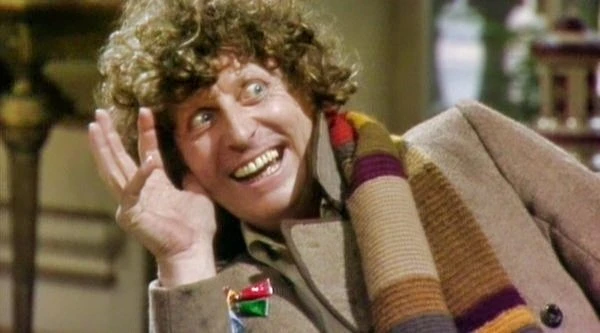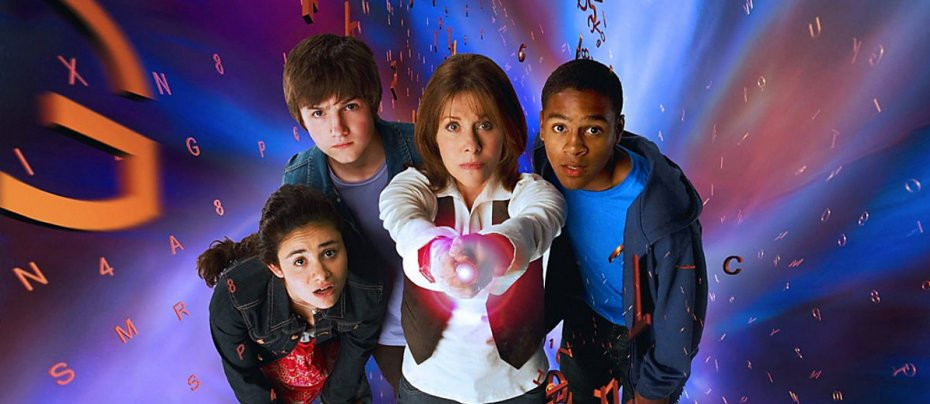City of Death

The original series of Doctor Who ran for twenty-six years, with 155 serials (at a conservative count) in all manner of story styles. There were historical epics, gothic horrors, Boy's Own adventures, military operations, comedy romps and high-concept sci-fi tales. Picking a favourite serial from such a varied range, over decades of production would seem to be impossible. And yet, every fan has a favourite story, and quite often the same names crop up. Genesis of the Daleks, The Caves of Androzani, Pyramids of Mars, Spearhead from Space, to name a few of the perennial favourites. One serial cited by many fans as the very best Doctor Who had the distinction of achieving the best audience numbers in the series' history. There were exceptional circumstances for that, but even if such a triumph was under spurious conditions, it couldn't have happened to a more deserving story: City of Death.
Filmed and broadcast in 1979 ("more of a table wine") City of Death stands out in a period of fun but unremarkable serials. By rights, Doctor Who's seventeenth season should be one of the best ever, starring as it does one of the greatest TARDIS teams. Tom Baker, in his sixth year as the Doctor, remained captivatingly charismatic but was, at times, drifting through the role. It took a truly strong script to get a genuinely great performance out of him, and this is really the only story of the season to do it. He was accompanied by Lalla Ward as Romana, the precocious young Time Lady of Gallifrey, who at times brought the very best out of Baker, and at others overshadowed him by putting in an intelligent performance while the programme's star was messing about. Neither actor was the first in their roles; Tom Baker was and remains the Fourth Doctor while Lalla Ward had replaced Mary Tamm, who left the part of Romana after one season. Yet both are held by many fans as the definitive versions of their characters, and it's true that when at their best they're hard to better.

Lalla Ward had already been on Doctor Who in the previous season's final serial, The Armageddon Factor, where she had impressed producer Graham Williams in her role as Princess Astra, and crucially, had got on well with Baker (something Tamm hadn't managed). Ward had already become something of a fixture of Saturday night TV, playing Lottie in The Duchess of Duke Street since 1977, as well as appearing on programmes such as Hazell and The Professionals after beginning in film with Vampire Circus, Rosebud and England Made Me. When Tamm announced she was to leave, she jokingly suggested Ward take over from her, something the production team thought was actually a very good idea after all. Fortunately, as a Time Lady, Romana could simply regenerate (although no explanation for why was ever given in the series). The chemistry she shared with Baker is clear on screen, even in their lesser stories; in a work such as City of Death, it's palpable. Watching it now, with the knowledge that within a year the two stars were married, it's clear to see that they're falling for each other throughout the filming. (Indeed, watching the stories of this and the following season, you can tell exactly when the two stars were getting along famously and when they'd had a fight by how they play against each other.)

Of course, it can't have hurt the budding romance that the city of City of Death is Paris. In fact, filming there – the first overseas location filming for the series – was the main reason the serial was made, but caused no end of behind-the-scenes difficulty. Given the tumult, it's astonishing the serial is half as good as it is, and it's quite a story in itself. Originally, the serial was written by David Fisher, who had provided two scripts for the previous season (The Stones of Blood and The Androids of Tara, two underrated gems themselves). Signed up to write another two scripts, under protest, and in spite of the fact his marriage was falling apart, he got down to it and wrote A Gamble With Time, a spy-caper in the manner of The Saint set mostly in a Monte Carlo casino (with excursions to Paris and Italy), where an alien being as using advanced technology to win impossible amounts of money to finance his nefarious plans. It had the potential to be a visual extravaganza, but an expensive one, and the series' accountant John Nathan-Turner (later the producer of the series from 1981 to its cancellation) calculated it would be cheaper to up sticks to Paris and film there than mock up the locations in studio. Everyone got very excited about this, except for Fisher, who, faced with a matter of days to rewrite his entire script, told them to go hang. Faced with about three days to make a workable script before initial studio filming began, producer Graham Williams locked himself and script editor Douglas Adams in his study over the weekend with a typewriter and a bottle of whisky. (Due to the BBC's crediting rules, the serial went out under the placeholder pseudonym "David Agnew.")
The result is a masterpiece. Largely written by Adams – and you can tell – but not without Williams's input, City of Death is easily the wittiest and funniest Doctor Who script of the period, probably ever. Adams had, of course, form with both Monty Python and The Hitchhiker's Guide to the Galaxy. Yet this is among his very best works – good enough that he'd reuse much of the concepts for his 1987 novel, Dirk Gently's Holistic Detective Agency, along with elements of the season's un-broadcast finale, Shada. Adams was notorious not only for reusing his ideas, but for being hopeless with deadlines, but it seems that the harsher the deadline, the better. Given a weekend to create a full script, he excelled himself. Unlike the rest of season seventeen, which consists of generic sci-fi runarounds (with a smattering of Adams wit), City of Death is an ingenious story that embraces the concept of a Paris setting and the cultural background that entails.

The Doctor and Romana arrive in (then-contemporary) Paris for a holiday, only to be pulled into a time-twisting crime caper at the hands of one Count Scarlioni, played by the great Julian Glover. Already a respected character actor, but sometime off his beloved roles in For Your Eyes Only and Indiana Jones and the Last Crusade, Glover is exceptionally charming and classy as the millionaire crime boss and art collector. Using his wealth he has financed some remarkable technology with which he plans to steal the Mona Lisa, although the work is done by his brutish manservant Hermann ("What a wonderful butler, he's so violent!")

The Doctor and Romana are swept up in events when they visit the Louvre, where the Doctor notices that one of the patrons is using some advanced extra-terrestrial technology as a bracelet. This is the Countess Scarlioni, played by Hungarian actress Catherine Schell, known for Space: 1999, On Her Majesty's Secret Service and The Return of the Pink Panther, in which she played Lady Claudine Lytton, not entirely different to the Countess. She's impeccable as the sophisticated and spoilt Countess, clearly used to being the centre of attention ("You're a beautiful woman, probably.") The Doctor and Romana find themselves followed by both the Count's men (after stealing the Countess' bracelet) and Duggan, a private investigator. Played by Tom Chadbon (one of those character actors who's had appearances on everything from Out of the Unknown to Casualty to Foyle's War), Duggan is a simple-minded sleuth who thinks he's far cleverer than he really is, and who's main skills are breaking-and-entering and thumping people. When they're all brought before the Count, Duggan becomes a short-term companion to the Time Lords. In fairness to him, he does know plenty about the criminal fraternity and the art world; it's hardly his fault that he's completely out of his depth when it comes to time-travelling aliens.

Having made the trip to Paris, the production team clearly intended on getting their money's worth from the city. A slight error in timing meant that much of the city's attractions were shut when they were over for filming – in those days, May Day wasn't a bank holiday in the UK, but the whole weekend was time off for France – but that didn't stop them taking in as much of the Parisienne scenery as possible. There's plenty of time up and around the Eiffel Tower, of course, and long stretches where nothing much happens beyond the Doctor and Romana running around the city. These sequences are one of the few parts of the serial that tend to receive criticism, but they add to the holiday atmosphere of the proceedings. It's obvious that the Doctor and Romana – and Baker and Ward – are having a jolly lovely time for much of the story. It's all backed up by Dudley's Simpson's charming and hummable score.

Juxtaposed to this is an entirely different visual element. The serial begins at a desolate vista, where a strange, insectile spacecraft sits. It's a remarkable combination of set and model work, one that sets up a story in the mode of the rest of the season – all alien planets and space travel. Within the ship sits a single alien, of a truly striking design – knotted strands of green flesh around a single, cyclopean eye. The alien tries to take off in his ship, leading to a devastating explosion – and then we join the Doctor and Romana in Paris. There doesn't appear to be any link between the two strands until the end of the first episode, when Scarlioni, alone in his study, and for reasons best known to himself, removes his human face to reveal that same alien visage. (It's best to not ask how he could fit his oversized green head within the human mask. Less concerning is that his wife has never noticed – she's clearly a beard anyway.)

It's a truly remarkable cliffhanger, suddenly changing the nature of the story from a picturesque crime caper to a sci-fi mystery. The serial is full of reveals like this, which add level after level of intrigue to the story. Within his cellar, Scarlioni's pet scientist Kerensky experiments with time, causing temporal echoes to occur throughout the city. Kerensky is played with a ludicrously over-the-top Russian accent by David Graham, best known at the time for voice work on Thunderbirds, but now most famous as the voice of Grandpa Pig on Peppa Pig. Locked in the same cellar as prisoners, the Doctor, Romana and Duggan uncover a stash of Mona Lisa copies – six of them, every one utterly perfect, seemingly painted by Leonardo da Vinci himself.

Why would anyone with six Mona Lisas go to the trouble of stealing a seventh? Well, there are seven people in the art world who would pay tens of millions to own the Mona Lisa, but none of them are going to buy it when it's hanging in the Louvre. Upon escaping, the Doctor takes the TARDIS back to Leonardo's studio in the 16th century. Sadly, we don't get to meet the Maestro, but we do see that he's been given instructions to paint an extra six copies of the Mona Lisa ("That dreadful woman with no eyebrows who wouldn't sit still,") for one Captain Tancredi. His appearance provides the second astonishing cliffhanger – Tancredi is the same man as Scarlioni!

It's an utterly ingenious plot. Some of the elements began life in Fisher's original script, but by the time Adams and Williams had finished, around a line per episode remained. The central concept is all Adams: Scarlioni is actually Scaroth, the last of the Jagaroth, who was splintered in time when his spacecraft exploded on prehistoric Earth. His various iterations have set themselves up in positions of influence throughout Earth's history, guiding humanity to the point when, in the twentieth century, his final incarnation can utilise enough technology to go back in time and prevent the disaster ever occurring. Of course, to use Kerensky's time technology to go back so far requires immense power, which requires enormous sums of money – hence his little plot with Leonardo. He can sell the Mona Lisa seven times over!

Naturally, the Doctor tries to scupper his plans, writing "This is a fake" on the canvas of each of the copies and leaving a note for his friend Leo to just paint over them. In the end, Scarlioni doesn't even need the paintings, tricking Romana into fixing the time tech for him so that he can go back in time with only a fraction of the power. What Romana doesn't realise is that the explosion of the ship is what sparked the beginnings of life on Earth itself, and if Scarlioni undoes his fate, humanity will never have existed. The final episode boils down to a race against time (quite literally) as the Doctor, Romana and Duggan rush across Paris to reach the TARDIS so they can stop Scarlioni in the past (and you never can get a taxi in Paris). They travel back to the prehistoric vista of 400 million BC – never mind that this is completely the wrong era, and that life was already well established by then, the mid-Devonian, nor that a prebiotic Earth would have an unbreathable atmosphere. Adams fixed these errors when he reworked the story elements for Dirk Gently, but for now, just let the nonsense go.
Of course, it all comes good, and Scaroth/Scarlioni is defeated. The destruction of his time machine, however, burns down his chateau, taking six of the seven Mona Lisas with it. The one that's left is dutifully returned to the Louvre, in spite of having "This is a fake" written on its canvas in felt tip. Of course, it'll show up on any X-ray, but if they have to X-ray it to know if it's any good, "serve them right." It's a wonderful final episode to a serial brimming with wit, endlessly quotable lines and ingenious concepts, and just when you think it can't get any better, there's a beautiful cameo by Eleanor Bron and John Cleese, who owed Adams a favour. Just delightful.

The colourful story of the serial's production doesn't end there. In 1979, industrial strikes blighted British television production. While this would effect the BBC, and Doctor Who in particular, by the end of the year, ITV was hit worse, and in late September to early October, it was switched off completely. This left the BBC with no competition, which goes some way to explaining the record-breaking ratings the serial achieved. However, the highest viewership of all was for episode four – an astonishing 16.1 million – which was broadcast the week after the strike ended. Evidently, word of mouth had got about enough that viewers tuned in specially to catch the last episode even though ITV was back on. Whatever the explanation, City of Death deserves its record-breaking position.
As ever, though, truth is somehow even stranger than art. In 1911, one Vincenzo Peruggia, a Louvre employee, stole the Mona Lisa from its casing overnight. It remained in his possession for two years, during which time, crowds came to the Louvre to see the place it used to hang. And would you know it, the ratings for City of Death could have been even higher, if several million people didn't tune into ITV when it was down, just to watch the apologetic caption card.
Review by Daniel Tessier









